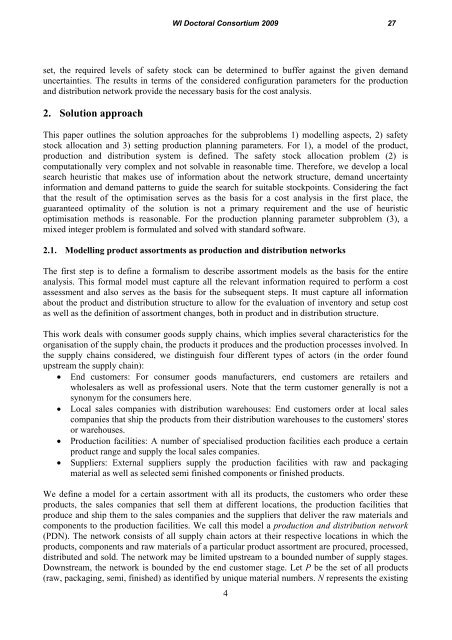Tagungsband zum Doctoral Consortium der WI 2009
Tagungsband zum Doctoral Consortium der WI 2009
Tagungsband zum Doctoral Consortium der WI 2009
Erfolgreiche ePaper selbst erstellen
Machen Sie aus Ihren PDF Publikationen ein blätterbares Flipbook mit unserer einzigartigen Google optimierten e-Paper Software.
set, the required levels of safety stock can be determined to buffer against the given demand<br />
uncertainties. The results in terms of the consi<strong>der</strong>ed configuration parameters for the production<br />
and distribution network provide the necessary basis for the cost analysis.<br />
2. Solution approach<br />
<strong>WI</strong> <strong>Doctoral</strong> <strong>Consortium</strong> <strong>2009</strong> 27<br />
This paper outlines the solution approaches for the subproblems 1) modelling aspects, 2) safety<br />
stock allocation and 3) setting production planning parameters. For 1), a model of the product,<br />
production and distribution system is defined. The safety stock allocation problem (2) is<br />
computationally very complex and not solvable in reasonable time. Therefore, we develop a local<br />
search heuristic that makes use of information about the network structure, demand uncertainty<br />
information and demand patterns to guide the search for suitable stockpoints. Consi<strong>der</strong>ing the fact<br />
that the result of the optimisation serves as the basis for a cost analysis in the first place, the<br />
guaranteed optimality of the solution is not a primary requirement and the use of heuristic<br />
optimisation methods is reasonable. For the production planning parameter subproblem (3), a<br />
mixed integer problem is formulated and solved with standard software.<br />
2.1. Modelling product assortments as production and distribution networks<br />
The first step is to define a formalism to describe assortment models as the basis for the entire<br />
analysis. This formal model must capture all the relevant information required to perform a cost<br />
assessment and also serves as the basis for the subsequent steps. It must capture all information<br />
about the product and distribution structure to allow for the evaluation of inventory and setup cost<br />
as well as the definition of assortment changes, both in product and in distribution structure.<br />
This work deals with consumer goods supply chains, which implies several characteristics for the<br />
organisation of the supply chain, the products it produces and the production processes involved. In<br />
the supply chains consi<strong>der</strong>ed, we distinguish four different types of actors (in the or<strong>der</strong> found<br />
upstream the supply chain):<br />
• End customers: For consumer goods manufacturers, end customers are retailers and<br />
wholesalers as well as professional users. Note that the term customer generally is not a<br />
synonym for the consumers here.<br />
• Local sales companies with distribution warehouses: End customers or<strong>der</strong> at local sales<br />
companies that ship the products from their distribution warehouses to the customers' stores<br />
or warehouses.<br />
• Production facilities: A number of specialised production facilities each produce a certain<br />
product range and supply the local sales companies.<br />
• Suppliers: External suppliers supply the production facilities with raw and packaging<br />
material as well as selected semi finished components or finished products.<br />
We define a model for a certain assortment with all its products, the customers who or<strong>der</strong> these<br />
products, the sales companies that sell them at different locations, the production facilities that<br />
produce and ship them to the sales companies and the suppliers that deliver the raw materials and<br />
components to the production facilities. We call this model a production and distribution network<br />
(PDN). The network consists of all supply chain actors at their respective locations in which the<br />
products, components and raw materials of a particular product assortment are procured, processed,<br />
distributed and sold. The network may be limited upstream to a bounded number of supply stages.<br />
Downstream, the network is bounded by the end customer stage. Let P be the set of all products<br />
(raw, packaging, semi, finished) as identified by unique material numbers. N represents the existing<br />
4

















